
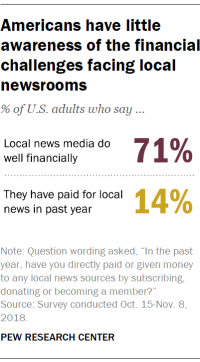
Local newsrooms across the country are struggling financially amid declines in revenue and staffing, but the public is broadly unaware of these challenges. A majority of U.S. adults believe their local news media are doing well financially, even as only 14% say they have paid for local news themselves in the past year, either through subscribing, donating or becoming a member, according to a Pew Research Center survey conducted last fall.
While few Americans overall pay for local news, some people are more likely to do so than others. Here’s a look at these differences, as well as Americans’ perceptions about the financial well-being of their local media.
Older Americans, white adults, those with college degrees more likely to pay
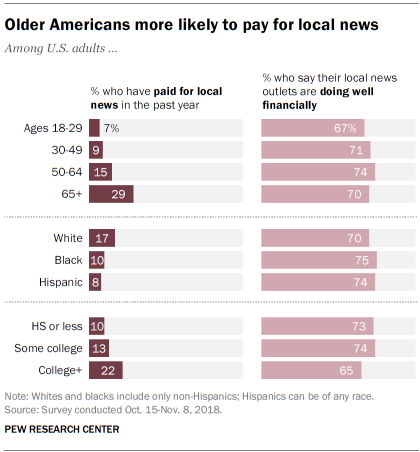
Americans ages 50 and older are more likely to pay for local news than their younger counterparts. Around three-in-ten (29%) of those ages 65 and older and 15% of those 50 to 64 say they have paid a local news organization in the past year. By comparison, just 9% of those ages 30 to 49 and 7% of those 18 to 29 say they have done so.
White Americans and those with a college education are also more likely to pay for local news than their counterparts. For example, a little over two-in-ten Americans with a college degree (22%) say they have paid for local news in the past year, compared with 13% of those with some college education and just one-in-ten of those with a high school diploma or less.
When it comes to how Americans perceive the financial health of their local news media, those with a college degree, those ages 18 to 29 and white Americans are all slightly more pessimistic than their peers. In all cases, however, majorities think their local news media outlets are doing well financially.
Americans who prefer print news products are more likely to pay for local news
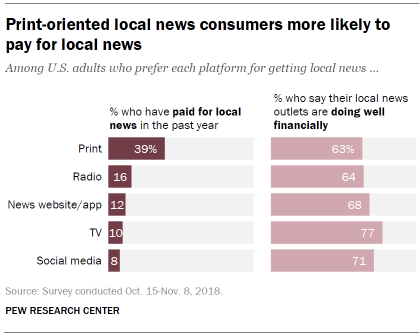
Americans who prefer to get their local news in print are much more likely to pay for it than those who prefer other platforms. About four-in-ten of these news consumers (39%) say they have paid for local news in the past year. That is more than double the share among those who prefer to get news either from the radio (16%) or news websites or apps (12%), and around four times the share of those who prefer to get local news from TV (10%). It also far exceeds the share among those who prefer to get local news via social media (8%).
Print news consumers are also more pessimistic about the financial well-being of their local news media when compared with most other groups. Almost six-in-ten print consumers (63%) think their local news media outlets are doing well financially, 15 percentage points lower than the share among those who prefer TV for local news (77%). Those who prefer radio are about on par with those who prefer print, while those who prefer digital platforms fall in between.
Civic engagement, community attachment increase likelihood of paying for news
U.S. adults who are more civically engaged – those who have participated in a political event in the past year or are currently active in or a member of a local group or organization in their community – are far more likely to pay for local news than those who are less engaged. Roughly three-in-ten (29%) of those who are highly active in their local community say they have paid for local news in the past year. That is almost twice the rate of those who are somewhat active (14%) and about five times the rate of those who are inactive in their community (6%).
Those who feel attached to their community are also more likely to pay for local news. Nearly a quarter (24%) of those who report being highly attached to their local community say they have paid for local news in the past year. By comparison, 14% of those somewhat attached and 7% of those not very or not at all attached say they have paid for local news.
Additionally, those who feel highly attached their community are also more likely to say their local news media are doing well financially than are those who are not very or at all attached (75% vs. 64%, respectively).
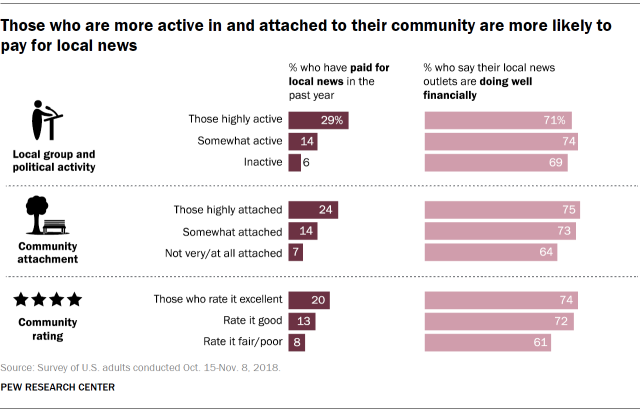
Americans interested in many local news topics aren’t more likely to pay
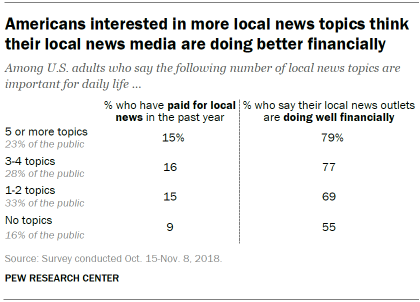
The survey asked Americans how important it is to follow 11 different local news topics, including weather, crime, sports, government and politics and local schools. Those highly interested in five or more of these topics are no more likely to pay for local news than those highly interested in fewer topics, with one exception: Those who say no topics are important for their daily lives are less likely to pay for local news.
Notably, those who express interest in a broader range of topics are much more likely to say their local news media are doing well financially. For instance, among those who say five or more topics are important for their daily lives, almost eight-in-ten (79%) say their local news outlets are doing well financially, compared with just 55% who say no topics are important.
Note: See full topline results and methodology.